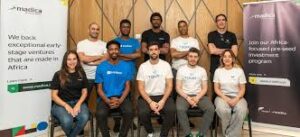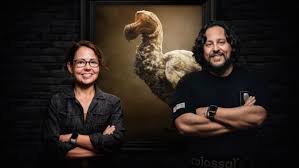THE NEWS: What Happened
A Dallas-based biotechnology company pursuing the resurrection of extinct species has extended its Series C funding round to $320m, achieving a $10.3bn valuation that positions de-extinction as one of venture capital’s most audacious investment themes. Colossal Biosciences, founded in 2021 by entrepreneur Ben Lamm and Harvard geneticist George Church, secured an additional $120m to advance projects aimed at reviving the dodo bird, woolly mammoth, thylacine, and dire wolf through advanced genetic engineering and reproductive biology technologies.
The company’s latest scientific breakthrough involves successfully culturing pigeon primordial germ cells—embryonic precursors to reproductive cells—for extended periods, marking the first time such cells have been maintained long-term outside chicken and geese species. This advancement enables broader gene editing applications across avian species while supporting the company’s flagship dodo revival project, which uses the Nicobar pigeon as the closest living genetic relative for reconstruction efforts.
Colossal has assembled over 170 scientists across facilities in Dallas, Boston, and Melbourne, developing integrated technologies spanning CRISPR gene editing, reproductive biology, computational genomics, and cryopreservation methods. The company has raised more than $555m since inception, attracting investors including filmmaker Peter Jackson, Los Angeles Dodgers owner Mark Walter’s TWG Global, and venture capitalist Bob Nelsen, while building breeding colonies and advancing toward first mammoth embryo creation by late 2026.
THE INTELLIGENCE: What It Means
This funding round represents investor confidence in biotechnology applications that extend far beyond the headline-grabbing de-extinction projects toward systematic biodiversity management and genetic rescue technologies with substantial commercial applications. The $10.3bn valuation suggests venture capital recognition that Colossal’s technological platform development could create significant value across conservation, agriculture, and pharmaceutical sectors regardless of whether extinct species are successfully revived.
The scientific progress indicators—sustained cell cultures, breeding colony establishment, and approaching embryo development milestones—provide concrete validation that de-extinction research has moved beyond theoretical speculation toward systematic biological engineering. The successful cultivation of pigeon germ cells represents technical advancement that enables genetic manipulation across broader species ranges, creating applications for endangered species protection and agricultural breeding enhancement that justify commercial investment beyond pure de-extinction objectives.
The investor composition reveals sophisticated understanding of biotechnology platform potential rather than speculative investment in science fiction concepts. Mark Walter’s emphasis on “impactful advancements in conservation through AI, computational biology, and genetic engineering” indicates recognition that Colossal’s technological development creates tools applicable across existing conservation challenges, endangered species management, and agricultural genetics rather than depending entirely on successful species resurrection for commercial viability.
The international collaboration framework—including partnerships with Mauritius government officials for dodo reintroduction and New Zealand research institutions for moa restoration—demonstrates a systematic approach to ecosystem integration and regulatory approval that addresses critics’ concerns about ecological disruption while building operational frameworks for eventual species reintroduction across multiple jurisdictions.
The platform approach deserves particular attention, as founder Lamm’s positioning of Colossal as a “systems company” comparable to satellite deployment or software development suggests technological capabilities that extend beyond biological applications toward broader genetic engineering and reproductive biology platforms. This framing may explain continued investor interest despite extended development timelines and uncertain outcomes for specific de-extinction projects.
The timing coincides with growing recognition that traditional conservation approaches prove insufficient for addressing accelerating species extinction rates and ecosystem degradation, creating market opportunities for technological solutions that can supplement or replace conventional biodiversity protection strategies. Companies that develop effective genetic rescue and species restoration capabilities may capture substantial value as conservation funding increases and regulatory frameworks adapt to accommodate biotechnological conservation methods.
THE BRIDGE: What To Do About It
For venture capitalists evaluating biotechnology platform opportunities, Colossal’s funding success highlights investment themes around systematic genetic engineering capabilities that create value across multiple application areas rather than depending on single breakthrough outcomes. The most compelling opportunities appear to be companies developing foundational technologies for genetic manipulation, reproductive biology, and species restoration that serve existing commercial markets while building capabilities for more ambitious long-term applications.
Similar opportunities warranting strategic evaluation:
- Agricultural genetic rescue platforms: Companies developing technologies to restore genetic diversity in crop species and livestock breeds, particularly those addressing climate adaptation and disease resistance challenges facing food production systems
- Endangered species biotechnology: Startups building genetic tools for wildlife conservation, including cryopreservation, artificial reproduction, and genetic diversity restoration for threatened populations in zoos and protected areas
- Marine biodiversity restoration: Companies applying genetic engineering and reproductive biology to coral reef restoration, fish population enhancement, and marine ecosystem rebuilding efforts supported by government and conservation organization funding
Active investors in biotechnology platform development:
- TWG Global: Mark Walter’s investment vehicle now demonstrated confidence in long-term biotechnology platform development, likely seeking similar systematic approaches to biological engineering across conservation and agricultural applications
- Venture capital firms with life sciences focus: Sophisticated biotechnology investors evaluating genetic engineering platforms with multiple application pathways rather than single-indication therapeutic development
- Conservation finance organizations: Impact investors and development finance institutions increasingly interested in technological solutions for biodiversity preservation and ecosystem restoration
- Agricultural strategic investors: Corporate venture arms from major agriculture companies seeking genetic engineering capabilities for crop improvement and livestock enhancement
For founders targeting genetic engineering and conservation technology markets, Colossal’s approach provides strategic guidance about building sustainable biotechnology platforms through systematic technological development rather than depending on single breakthrough applications. The emphasis on creating foundational tools for genetic manipulation and reproductive biology appears more attractive to investors than narrow applications dependent on uncertain scientific outcomes.
Market positioning should emphasize platform capabilities and multiple application pathways rather than specific project outcomes, as investors appear more comfortable evaluating systematic technological development than speculative scientific achievements. Colossal’s success in maintaining investor confidence despite extended development timelines suggests that demonstrable technical progress and clear application opportunities may prove more important than near-term commercial products.
International collaboration and regulatory engagement deserve early attention for biotechnology companies addressing conservation and genetic engineering applications, as successful deployment requires government approval and ecosystem integration across multiple jurisdictions. Companies that develop regulatory expertise and stakeholder relationships early may achieve competitive advantages over technically superior competitors lacking operational frameworks for real-world deployment.
Technology development should prioritize creating tools and platforms that serve existing commercial markets while building capabilities for more ambitious long-term applications, as this approach provides revenue validation and investor confidence during extended development periods required for breakthrough biological engineering achievements.
For established biotechnology and conservation organizations evaluating competitive responses to genetic engineering platforms, Colossal’s model suggests that systematic technological development may provide sustainable advantages over traditional conservation approaches that depend primarily on habitat protection and species management without genetic intervention capabilities.
Corporate development opportunities exist for companies seeking genetic engineering and reproductive biology capabilities, particularly those in agriculture, pharmaceuticals, and conservation sectors that could benefit from Colossal’s technological platform rather than specific de-extinction applications. The systematic nature of the company’s technological development may provide acquisition opportunities for established players seeking rapid capability development.
Environmental and agricultural applications represent substantial market opportunities for genetic engineering platforms, particularly as climate change and ecosystem degradation create increased demand for technological solutions that can supplement traditional conservation and agricultural improvement methods through direct genetic intervention.








